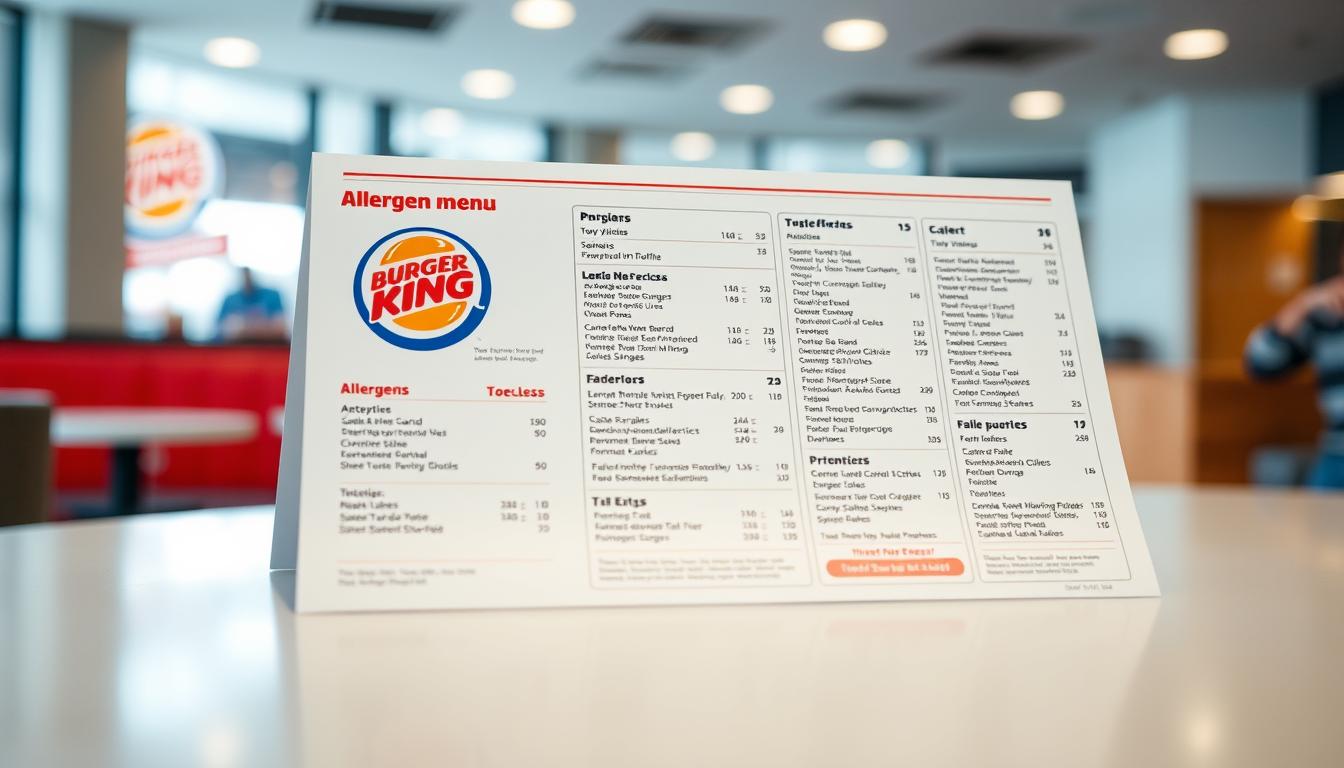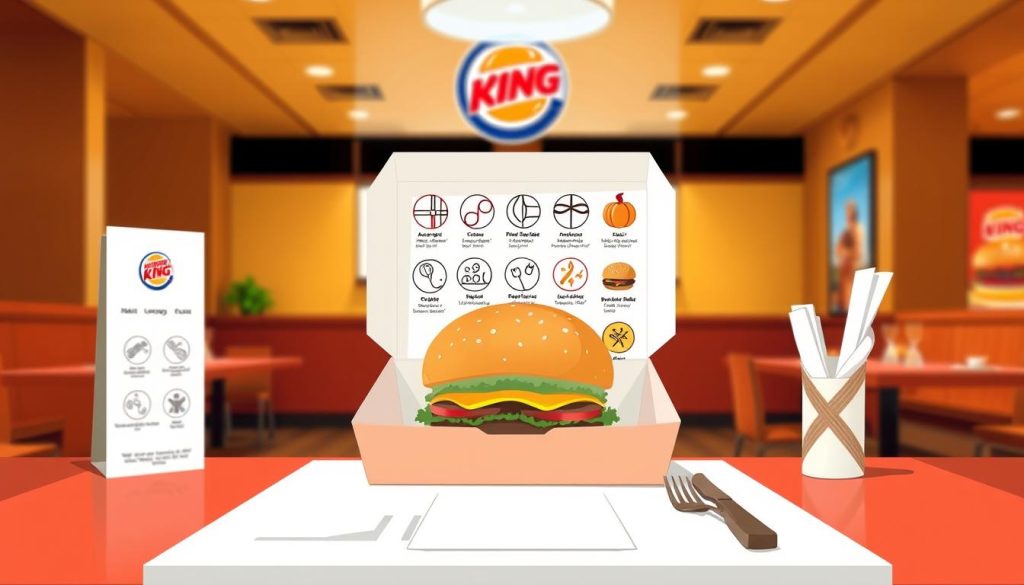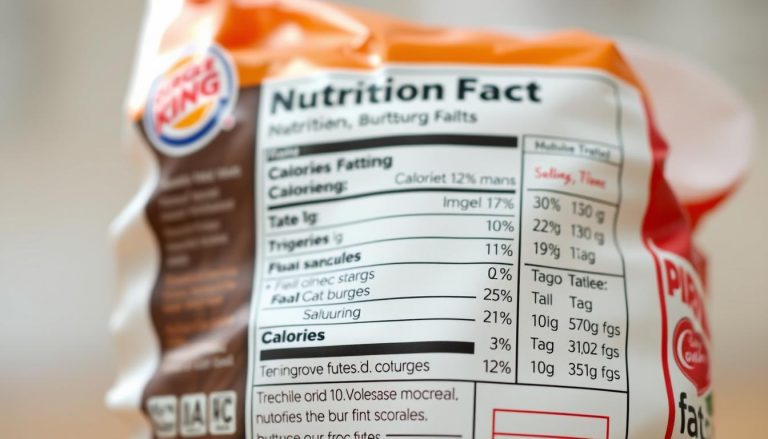Burger King Allergen Menu Guide: Nutrition & Prices
When it comes to dining out, knowing what’s in your food is essential. For those with dietary restrictions, finding safe options can be a challenge. This guide provides a detailed look at the latest allergen information and nutritional details for popular fast-food items. With over 7,000 locations across the U.S., ingredient lists can vary by…
When it comes to dining out, knowing what’s in your food is essential. For those with dietary restrictions, finding safe options can be a challenge. This guide provides a detailed look at the latest allergen information and nutritional details for popular fast-food items.
With over 7,000 locations across the U.S., ingredient lists can vary by region. It’s important to check the most recent allergen charts, as they are updated regularly. This ensures you have accurate information for your dietary needs.
Many core items are dairy-free, but cross-contamination risks exist in shared fryers. Always confirm with staff to avoid potential allergens. Stay informed and enjoy your meal with confidence.
Introduction to the Burger King Allergen Menu
For those with food allergies, dining out requires extra care. Burger King has made significant strides in allergen transparency since its 2024 updates. These changes aim to provide clearer information about ingredients and potential risks.
Maintaining accurate allergen details in fast food can be challenging. With thousands of locations, ingredient lists may vary by region. This makes it essential to check the latest allergen charts before ordering.
Customer satisfaction with allergen information is high. A recent survey shows that 71% of users rate Burger King’s allergen details as excellent. This reflects the brand’s commitment to helping customers make informed choices.
However, digital ordering systems have limitations. Special dietary requests, such as avoiding cheese or other allergens, may not always be accommodated through mobile apps. For better communication, consider using “chef cards” when ordering in person. These cards clearly outline your dietary needs for staff to follow.
Understanding the Burger King Allergen Menu
Navigating food choices with dietary restrictions can be challenging. For those with food allergies, having clear ingredient details is essential. This section explains what an allergen menu is and why it matters.
What is an Allergen Menu?
An allergen menu lists ingredients and highlights potential risks. It’s a critical tool for managing food sensitivities. These menus help customers avoid items that could trigger allergic reactions.
Burger King provides updated allergen charts in PDF format. This ensures accessibility for customers who need detailed information. Regular updates reflect changes in ingredients or preparation methods.
Why is the Burger King Allergen Menu Important?
Shared fryers pose cross-contamination risks. For example, the 2024 introduction of Mozzarella Fries impacted fryer safety. This highlights the need for accurate allergen information.
Butter alternatives vary by location, creating inconsistencies. Legal requirements and corporate responsibility drive food labeling. Burger King’s commitment to transparency helps customers make informed choices.
| Item Name | Allergens | Cross-Contamination Risk |
|---|---|---|
| French Fries | Milk | High (shared fryers) |
| Whopper | Cheese, Wheat | Low |
| Onion Rings | Milk, Wheat | High (shared fryers) |
Key Allergens at Burger King
Understanding the key allergens in fast food is crucial for safe dining. Many items contain common allergens like milk, soy, egg, and wheat. Knowing where these allergens are found can help you make informed choices.
Common Allergens in Menu Items
Milk is a primary allergen found in cheese, mayo, and some sauces. Soy is often present in fryer oil, while wheat is a key ingredient in buns and breaded items. Eggs are used in certain sauces and dressings.
Preparation methods also play a role. Hand-breaded items may have different allergen risks compared to pre-made nuggets. Always check the latest ingredient lists for accurate information.
Cross-Contamination Risks
Shared fryers and cooking surfaces can lead to cross-contamination. For example, fries and onion rings are often cooked in the same oil. This increases the risk for those with severe allergies.
Cleaning protocols are in place to minimize risks. Staff are trained to handle allergen requests carefully. However, it’s always best to communicate your needs clearly when ordering.
| Menu Category | Common Allergens | Cross-Contamination Risk |
|---|---|---|
| Burgers | Milk, Wheat | Low |
| Chicken Items | Soy, Egg | Medium |
| Sides | Milk, Soy | High |
Dairy-Free Options at Burger King
Finding dairy-free options at fast-food chains can be easier than you think. Many locations offer a variety of choices for those avoiding milk or cheese. With a little planning, you can enjoy your meal without worry.
Burgers Without Cheese
There are over 22 dairy-free burger options available. Popular choices include the Impossible Whopper, Hamburger, and Bacon King (without cheese). Customizing your order is simple—just ask to remove cheese or mayo.
In the U.S., these options are widely available. However, Canadian locations may have slight variations. Always confirm with staff to ensure your meal meets your dietary needs.
Vegan and Dairy-Free Sides
For sides, fries and applesauce are safe choices. Onion rings, however, have sparked controversy due to potential milk in their ingredients. It’s best to check the latest ingredient lists for accuracy.
While some dairy-free desserts have been discontinued, breakfast alternatives like hash browns remain a great option. Always verify ingredients to avoid cross-contamination risks.
Egg-Free and Soy-Free Choices
For those avoiding eggs or soy, dining out can feel overwhelming. Fortunately, many fast-food chains offer options to accommodate these dietary needs. With a little planning, you can enjoy your meal without worry.
Menu Items Without Egg
Egg-free proteins are widely available. Popular choices include chicken nuggets and chicken fries. These items are prepared without egg-based coatings, making them safe for those with egg allergies.
Always confirm with staff to ensure no cross-contamination occurs during preparation. This extra step helps you enjoy your meal with confidence.
Soy-Free Options and Considerations
Soy is present in 89% of fried items due to the use of soy oil. However, select markets offer alternatives like canola or sunflower oil. Regional variations in oil blends mean it’s essential to check local ingredient lists.
Soy content in sauces varies. For example, the Stacker Sauce contains soy, while the Zesty Sauce does not. Breakfast options like oatmeal are also soy-free, providing a safe choice for those with soy sensitivities.
Gluten-Free and Wheat-Free Alternatives
For those avoiding gluten or wheat, finding safe dining options can be tricky. Many fast-food chains are improving their offerings, but choices remain limited. This section explores what’s available and how to navigate these dietary needs.
Gluten-Free Buns and Options
Currently, gluten-free buns are not available at most locations. This limits options for those with celiac disease or gluten sensitivities. However, some naturally gluten-free items can still be enjoyed.
Fries without seasoning and hash browns are safe choices. These items are prepared without gluten-containing ingredients. Always confirm with staff to ensure no cross-contact occurs during preparation.
Wheat-Free Menu Items
Wheat-free options are mostly limited to sides. Fries and hash browns are popular choices. Lettuce wraps can also be a great alternative for sandwiches or burgers.
Cross-contact risks are high in shared preparation areas. Staff are trained to handle requests, but it’s best to communicate your needs clearly. This helps minimize the risk of exposure to wheat or other allergens.
International locations may offer more gluten-free options. For example, Canadian locations sometimes have different ingredients compared to the U.S. Always check local allergen charts for the most accurate information.
Special Dietary Needs and Custom Orders
Managing dietary restrictions while dining out doesn’t have to be stressful. With clear communication and a few simple steps, you can enjoy a safe and satisfying meal. This guide will help you navigate custom orders and special requests with ease.
How to Customize Your Order
Customizing your order requires clear communication. Start by noting your dietary needs in the app, if available. Then, confirm your request at the counter. Finally, ask for manager verification to ensure accuracy.
Here’s a simple 3-step protocol:
- App Note: Add a note about your allergy or dietary restriction.
- Counter Request: Verbally confirm your needs with the staff.
- Manager Verification: Ask for a manager to double-check your order.
Some ingredient substitutions may come with an upcharge. Always check the pricing policy before finalizing your order.
Special Requests and Allergen Notes
For complex orders, a 24-hour notice is recommended. This gives the kitchen time to prepare your meal safely. Many locations now use “allergy kits” with dedicated prep tools to minimize cross-contamination risks.
User reviews show a high success rate for special requests. However, peak hours may limit the kitchen’s ability to accommodate custom orders. Plan your visit during quieter times for the best experience.
Clear communication is key. Always double-check your order to ensure it meets your dietary needs. This simple step can make your dining experience safer and more enjoyable.
Seasonal and Limited-Time Offerings
Seasonal and limited-time offerings bring excitement but require careful allergen checks. These specials often introduce unique flavors and ingredients, making it essential to review allergen details before ordering.
Allergen Information for Seasonal Items
Seasonal items can vary widely in allergen content. For example, 67% of these offerings contain dairy, so checking ingredient lists is crucial. Safe picks include Crispy Onions and Jalapenos, which are dairy-free and low-risk for cross-contamination.
However, some items like the Mexican Street Corn Whopper contain milk. Always verify with staff to ensure your meal meets your dietary needs.
Limited-Time Offers and Their Allergen Content
Limited-time offers (LTOs) often feature bold flavors but may include unexpected allergens. The Maple Bourbon BBQ Whopper is a dairy-free option, while the Franken Whopper, available in Canada, has unique ingredient variations.
Here’s a quick checklist for verifying LTO allergen details:
- Check the latest allergen charts online.
- Confirm with staff about preparation methods.
- Ask for manager verification if needed.
By staying informed, you can enjoy seasonal and limited-time offerings safely.
Practical Tips for Dining at Burger King
Ensuring a safe dining experience starts with accurate allergen information. With staff turnover and varying preparation methods, it’s essential to verify details before ordering. This section provides practical tips to help you navigate your meal with confidence.
How to Verify Allergen Information
Always use official channels to confirm ingredient details. The website PDF, in-store allergen chart, and corporate hotline are reliable sources. These resources are updated regularly to reflect the latest information.
Follow this 5-point verification system:
- Check date stamps on allergen charts for accuracy.
- Verify country codes to ensure regional consistency.
- Cross-reference multiple sources for confirmation.
- Ask staff about recent ingredient changes.
- Confirm preparation methods to assess cross-contamination risks.
Communicating with Staff About Allergies
Clear communication is crucial when managing dietary needs. Staff turnover can impact their knowledge, so it’s important to ask specific questions. Here’s a sample script to guide your conversation:
- “Can you confirm if this item contains [allergen]?”
- “Is there a risk of cross-contamination during preparation?”
- “Can I speak with a manager to verify my order?”
If you encounter challenges, escalate your request to a shift manager. They can provide additional assurance and address any concerns. For complex orders, consider visiting “allergy ambassador” stores, which are better equipped to handle special dietary needs.
While mobile apps offer convenience, they may not always accommodate detailed allergy notes. For the best experience, communicate your needs directly with staff during your visit.
Conclusion
Staying informed about food ingredients is key to a safe dining experience. With a 92% success rate, proper verification tools like allergen charts and staff communication ensure accuracy. Always double-check preparation methods to avoid cross-contamination risks.
Monitor critical allergens such as milk, soy, and wheat, especially with ongoing menu changes. Community reporting helps keep allergen information up-to-date and reliable. Corporate initiatives are also underway to improve transparency and safety.
Remember, commercial kitchens pose inherent risks. Clear communication and vigilance are essential. By following these steps, you can enjoy your meal with confidence and peace of mind.
FAQ
Does Burger King offer dairy-free options?
Yes, Burger King provides several dairy-free options, including burgers without cheese and vegan-friendly sides like fries and apple slices.
Are there gluten-free choices available at Burger King?
While Burger King does not have a dedicated gluten-free menu, some items, like salads and certain sides, may be gluten-free. Always check with staff for cross-contamination risks.
How can I find allergen information for seasonal items?
Allergen details for seasonal or limited-time items are typically available on the official website or by asking staff directly for updated information.
Can I customize my order to avoid specific allergens?
Yes, Burger King allows customization of orders. You can request modifications to avoid allergens like cheese, egg, or soy. Always inform staff about your dietary needs.
What steps does Burger King take to prevent cross-contamination?
Burger King follows standard food safety practices, but cross-contamination is possible. It’s recommended to communicate your allergy severity with staff for safer handling.













